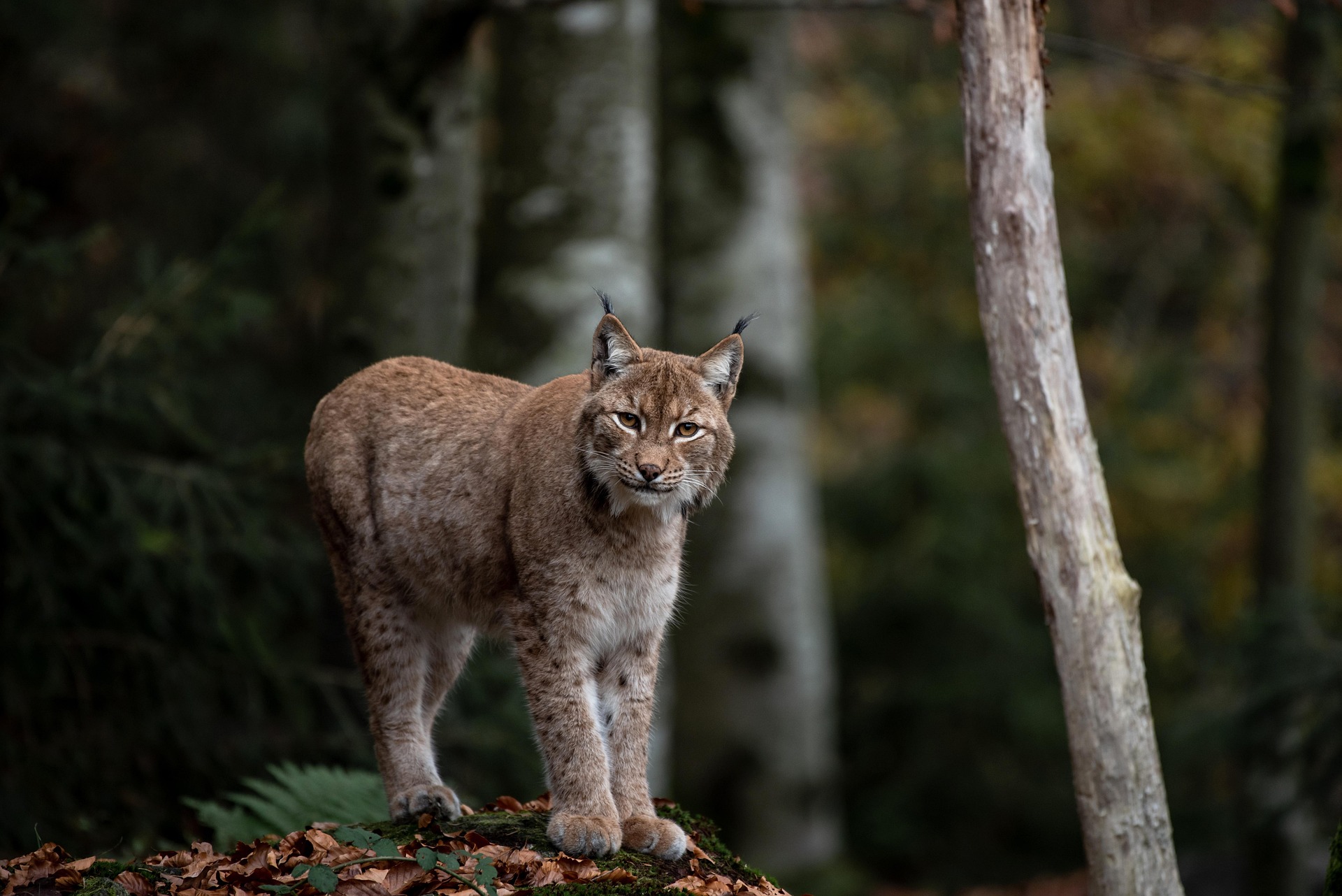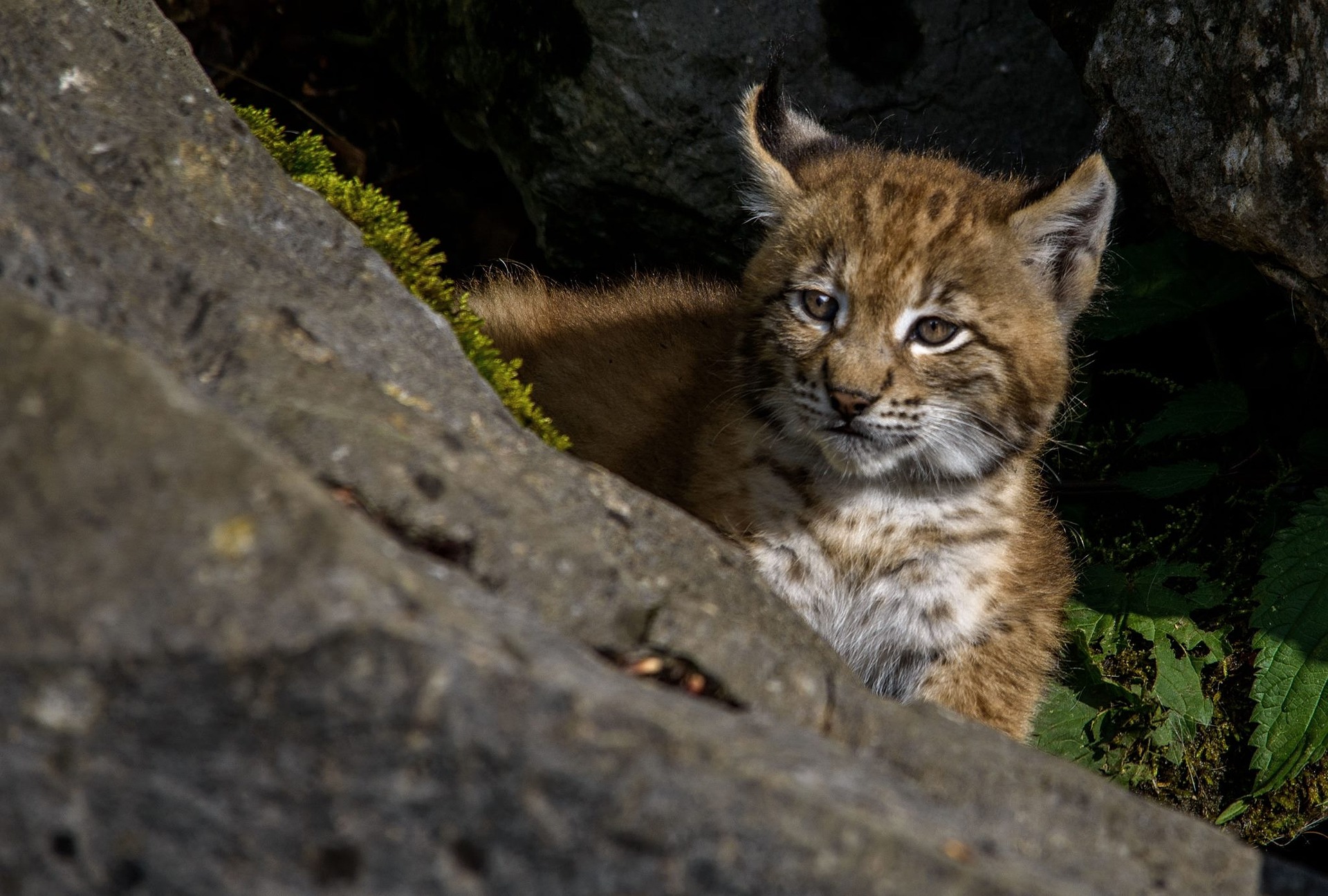Eurasian Lynx (Lynx lynx) is a large predatory mammal belonging to the cat family (Felidae), widely distributed across Eurasia. It is recognized by its long legs, short tail with a black tip, and distinctive black tufts on its ears. The fur color varies from gray to yellowish or reddish tones, and the coat pattern ranges from almost spotless to heavily spotted. Although it generally inhabits forested areas, it can also be found in open steppes and mountainous regions of Central Asia. While the species is currently classified as of Least Concern overall, some European subpopulations are considered threatened.
Morphological Characteristics
The Eurasian lynx (Lynx lynx) is the largest lynx species within the cat family, and its morphological traits vary noticeably depending on the region it inhabits. The body length ranges from 90 to 120 cm, the tail length from 19 to 23 cm, and body weight is typically between 17 and 25 kg. Northern and eastern populations are generally larger, and males are about 25–30% heavier than females.【1】 Its long legs and broad, densely furred paws allow it to move easily over snow.
The short tail has a black tip; the backs of the ears are black with a white spot, and the ear tips bear long black tufts. A distinct ruff forms around the face. The fur color varies from gray to yellowish or reddish hues, and the pattern ranges from unspotted to heavily spotted, sometimes even forming rosettes. The belly, chest, and inner sides of the legs are lighter in color. The Central Asian subspecies L. l. isabellinus has pale, almost unspotted fur. With these features, the species is well adapted to both forested and mountainous ecosystems.

Eurasian Lynx (pixabay)
Subspecies
- L. l. lynx (Northern lynx): Northern Europe and Western Siberia; from European Russia to the Yenisei River.
- L. l. carpathicus (Carpathian lynx): Carpathian Mountains and Central/Eastern Europe.
- L. l. balcanicus (Balkan lynx): The Balkans (Albania, North Macedonia, Montenegro, Kosovo).
- L. l. dinniki (Caucasian lynx): The Caucasus; extending south into Türkiye, Iraq, and Iran.
- L. l. isabellinus (Turkestan lynx): Central Asia (from Turkmenistan to China, India, Nepal, and Bhutan).
- L. l. wrangeli (Siberian lynx): Eastern Siberia, east of the Yenisei River; from Russia to China.
Distribution and Habitat
The Eurasian lynx is one of the most widely distributed carnivorous mammals in Eurasia. Its range extends from Scandinavia and Central Europe in the west, across the Siberian forests, to Central Asia, the Himalayas, and the Tibetan Plateau. Historically, it was widespread throughout Europe, Russia, and Central Asia, but human activities have caused fragmentation and local extinction in the western and southern parts of its range. Following its extinction in Western Europe, reintroduction programs have been implemented in several countries, including Austria, France, Switzerland, Germany, Slovenia, Italy, and the Czech Republic.
The species generally inhabits areas with dense forest cover. In Europe and Siberia, it prefers mixed forests of broadleaf and coniferous trees that provide abundant prey. In Central Asia, it inhabits more open woodlands, rocky slopes, and mountainous areas. It has been observed at high altitudes, from the northern slopes of the Himalayas up to the Tibetan Plateau (as high as 5,500 meters). Habitat selection is closely linked to prey availability and vegetation density, which offer cover for stalking and concealment. The lynx avoids open areas, and its distribution becomes more restricted as forest continuity declines.
Reproduction
The Eurasian lynx breeds once a year, typically between February and April. Females come into estrus for only about three days. After mating, the male leaves the area, and the female alone raises the young. The gestation period lasts 67–74 days, with births usually occurring in late May or early June. A litter typically consists of 2–3 kittens, though the number may range from 1 to 5. Newborn kittens weigh about 300–350 grams. They are weaned at around four months and become independent by ten months of age. Females reach sexual maturity at about two years old, while males mature at around three. Under favorable conditions, females can reproduce up to 14 years of age and males up to 17.

Eurasian Lynx Cub (pixabay)
Diet
The Eurasian lynx is a strictly carnivorous species. Its diet consists mainly of small to medium-sized ungulates. In Europe, its most common prey include roe deer (Capreolus capreolus), chamois (Rupicapra rupicapra), reindeer, and musk deer. When these prey species are scarce, the lynx turns to smaller animals such as hares, rabbits, foxes, birds, porcupines, marmots, and even domestic sheep and goats. It hunts by stalking its prey under dense vegetation or snow cover and then ambushing it with a sudden leap, usually killing it with a bite to the throat. The lynx consumes about 1–2 kilograms of meat per day and often caches the remains of its kill to feed on over several days. In its ecosystem, the lynx plays an important ecological role in regulating the populations of species such as roe deer and chamois.
Conservation Status
Due to its wide distribution and stable populations in the north, the Eurasian lynx is listed as Least Concern on the IUCN Red List. However, some isolated subpopulations in Europe are under severe threat; notably, the Balkan lynx (L. l. balcanicus) is classified as Critically Endangered, while the Bohemian–Bavarian and Vosges–Palatinate subpopulations are considered Endangered.
The species is protected under international agreements, including CITES Appendix II, the Bern Convention Appendix III, and the EU Habitats Directive Appendices II and IV. It is legally protected in many countries, such as Afghanistan, Albania, Austria, Azerbaijan, Bulgaria, China, the Czech Republic, France, Georgia, Germany, Greece, Iran, Italy, Kazakhstan, Kyrgyzstan, Poland, Slovenia, Switzerland, Türkiye, Turkmenistan, and Uzbekistan. However, limited hunting is permitted in certain countries like Sweden, Finland, and Romania, while controlled hunting seasons are in place in Estonia, Norway, and Latvia.
Across Europe, reintroduction programs have been implemented in regions where the species had become extinct, leading to the establishment of successful populations in Switzerland, Austria, France, Germany, Slovenia, the Czech Republic, and Italy. Nevertheless, poaching, habitat loss, fragmentation due to roads and settlements, and reduced genetic diversity remain major threats.
In Asia, the species’ status is poorly understood in many regions. Habitat degradation, decline of prey populations, illegal fur trade, and retaliatory killings are among the main threats. Inadequate protection, weak law enforcement, and limited monitoring efforts further exacerbate these problems, particularly in Central Asia.
In recent years, regional initiatives such as the Balkan Lynx Recovery Programme (since 2006) have been launched to raise awareness among local communities, strengthen wildlife monitoring, and enhance enforcement measures for the protection of the species.


